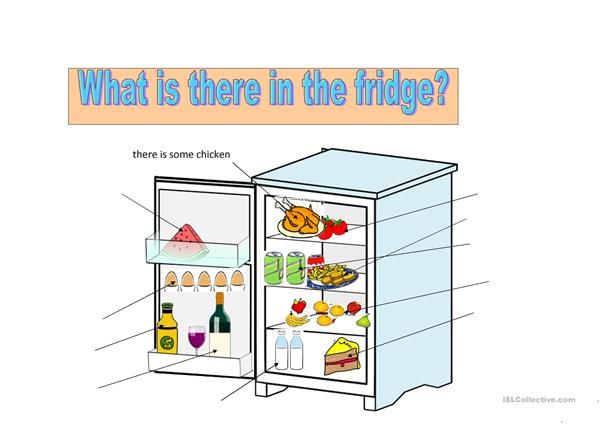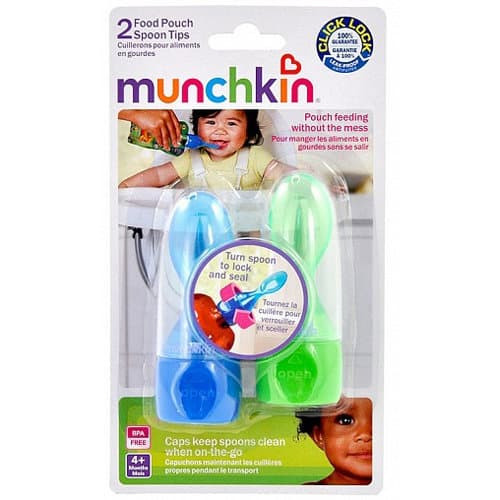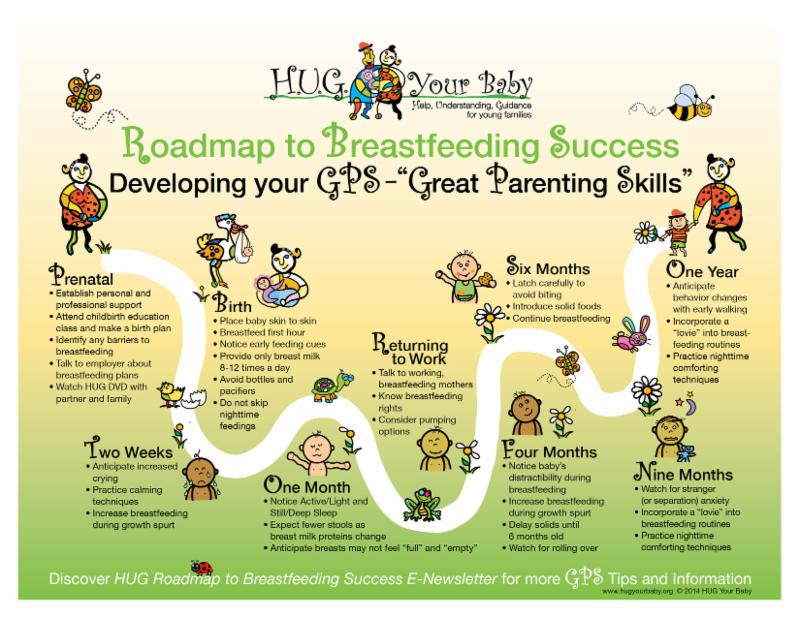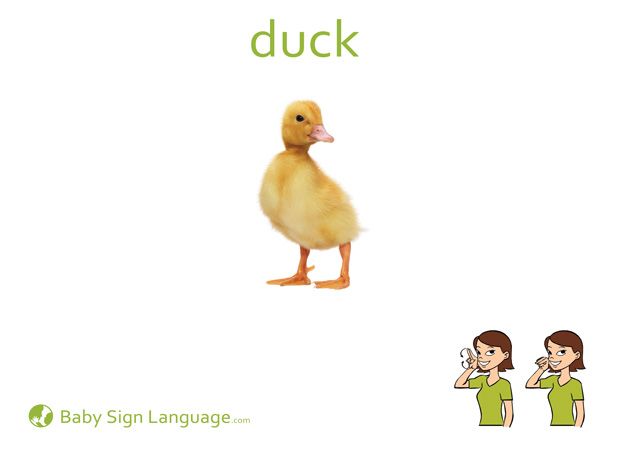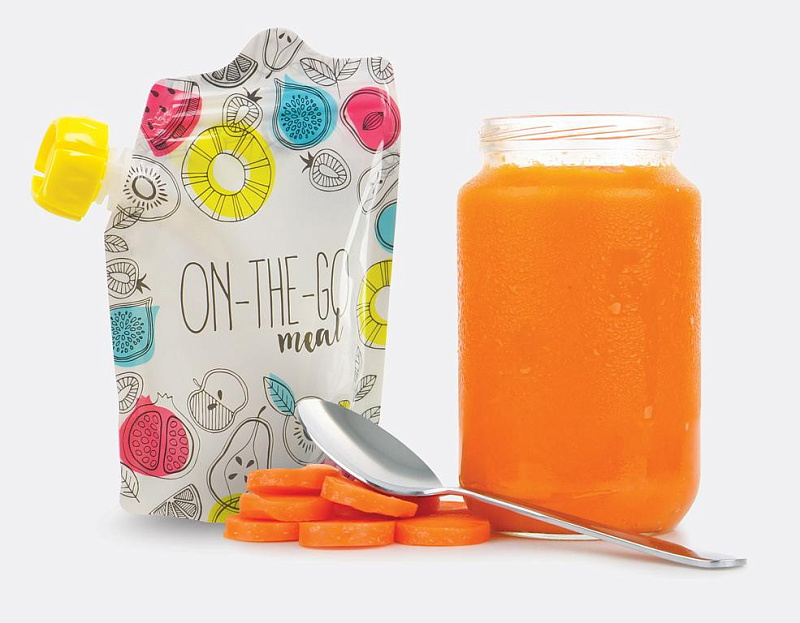What food to start weaning baby
Ultimate Guide to Baby Led Weaning (and Best First Foods)
Learn the basics of how to do the feeding approach known as “baby led weaning” and the best first foods for baby to make starting solids easy and fun. Plus: Learn why it’s perfectly okay to use a combined approach of blw and purees.
Baby Led Weaning
The feeding approach known as “baby led weaning” or “BLW” for short, is a style of feeding infants that allows them to feed themselves right from the start. The food is offered in thick finger-size pieces and is soft and easily squishable between your fingers. This way, the food is both easy to hold but has a low risk of choking.
TIP: This method became popular about a decade ago after the publication of the Baby Led Weaning: The Essential Guide to Introducing Solid Food by UK author Gill Rapley.
BLW Baby
One of the many reasons that people are starting to opt for this style of feeding more and more is simply that it’s easy. In many cases, you can modify foods you’re already making to share with your baby and there’s not always a lot of separate cooking involved. It also allows a baby to have control over what goes into their mouths, which sets a good precedent for letting them eat intuitively from the start.
What age should I start baby led weaning?
According to the American Academy of Pediatrics, a baby is ready to start solids with baby led weaning when:
- They’ve doubled their birth weight (at least).
- They can hold their head up well and are starting to sit up unsupported.
- They show signs of being interested in food (watching you eat, reaching for food when you’re eating, etc).
- When you feed them, they are able to move the food around in their mouths—rather than spit it right out.
TIP: Look for a highchair that allows a baby to sit up relatively straight so they can have good posture and better control over their arms and hands.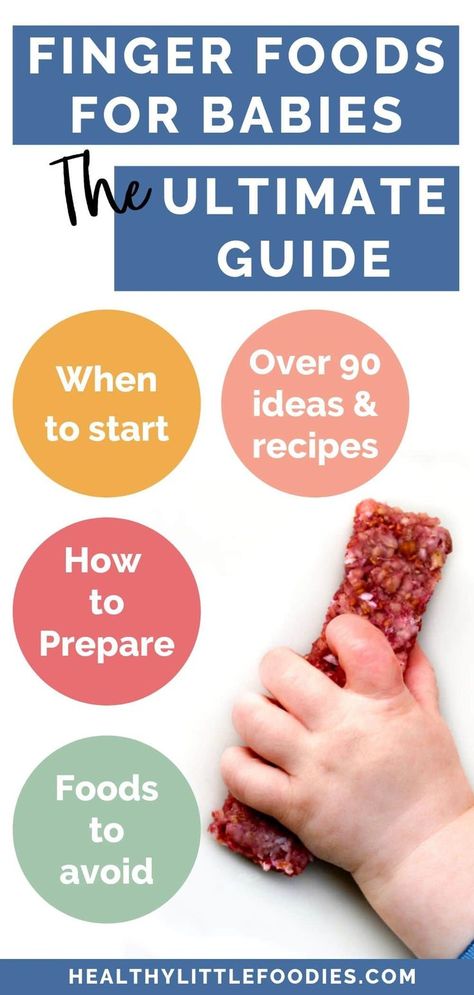
How to Start Baby Led Weaning
The first time you offer solids is such a fun milestone, so you’ll be ready once you follow these simple steps.
- Make sure baby has hit the milestones listed above to let you know that he’s ready to start.
- Get the highchair ready and adjust the straps and foot rest as needed.
- Plan to introduce water when you start solids. I recommend a trainer cup.
- Choose one food to start with and plan to offer only one food at a time.
- Stop when baby starts to fuss, turns his head away, or shows any other signs of not wanting to continue. It’s usually fairly obvious when they are done!
TIP: If you start offering solids and baby just doesn’t seem interested at all, it’s okay. Take a break for a few days or a few weeks and start again. Each kiddo has their own unique timeline.
Best Tips for Starting BLW
Here are a few more tips to consider and review before you get started.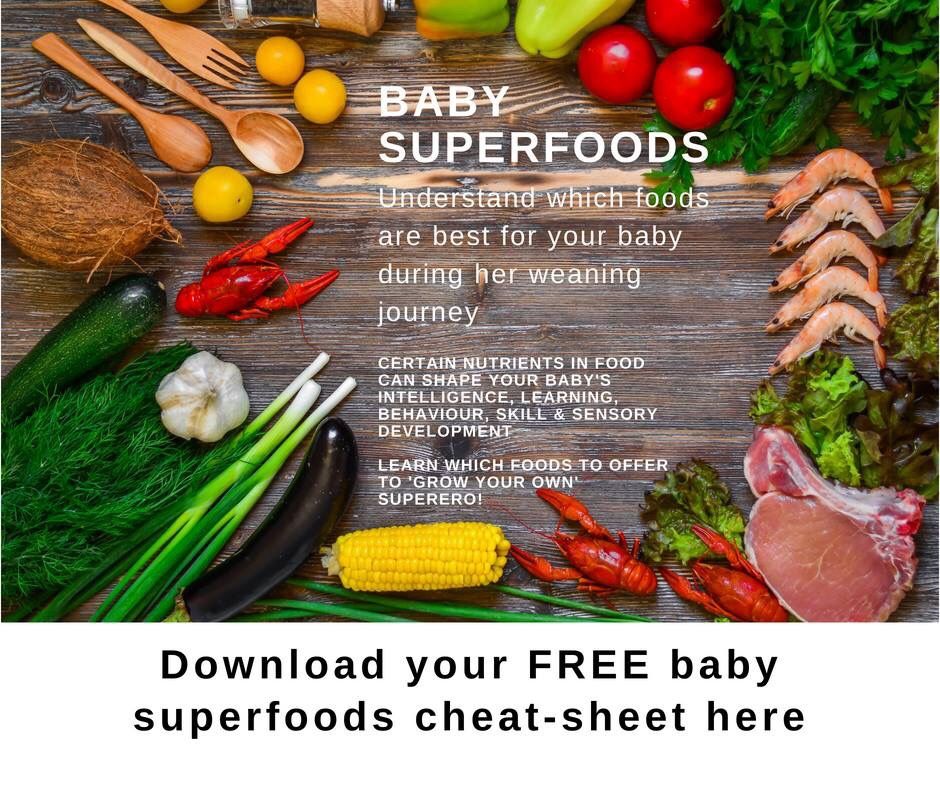
- Understand the gag reflex. Gagging is different than choking though and is most often a sign that baby is learning to move food around in their mouths—and to get it out of their mouths, which is a skill you want them to have!
- Brush up on the basics of how to know when baby is ready to start solids. (Go back to the top of this post for the signs to look for.)
- Set them up for success with a highchair that allows them to sit up straight and has foot support.
- Sit with them as you offer food.
- Check your own expectations of what will happen and simply allow your baby to take the lead.
- Start with one new food a day or every few days.
- Vary the textures of foods you offer to start exposing baby to many right from the start.
- Offer water in a sippy cup or small open cup.
TIP: Remember that breastmilk or formula will continue to satisfy baby’s hunger for the first few months of eating solids. Do not expect solids to replace milk feedings at this age.
First Foods for Baby
Starting solids with baby led weaning or purees are both perfectly acceptable ways to introduce a baby to solid foods—but the topic can get so heated! There’s a lot of pressure to do it the “right” way and I’m here to say that there isn’t one. You 100% can do one or the other, or combine the two to make it work for your family. It’s all good!
Remember, the goal with first foods for baby is that they’re introduced to flavors, nutrients, and foods they can easily eat or suck on. It should be an enjoyable milestone for all involved.
TIP: It’s a good idea to get into the habit of offering an iron-rich food since iron stores in babies start to run out around 6 months and they’ll need to start ingesting it in their food.
Best First Foods for Baby Led Weaning
Here are some of our favorite first foods to offer baby led weaning style. You want foods to be finger sized so they are large enough that baby can’t force the whole piece into their mouth, and a shape that’s easy for a 6 month old to hold with their chubby little hands.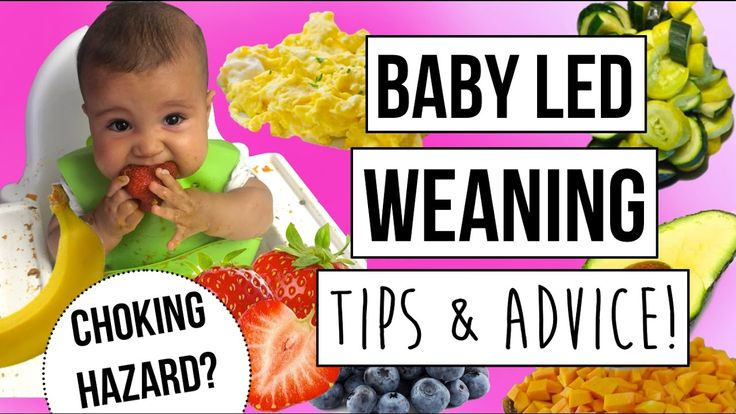 These are some of our favorites.
These are some of our favorites.
- Roasted sweet potato wedges
- Roasted apple wedges, skin on to help them hold together
- Roasted or steamed broccoli florets (big enough for baby to hold)
- Melon slices
- Thick mango slice
- Banana with some of the peel still on
- Toast sticks with mashed avocado
- Avocado spears (make sure the avocado is ripe and soft)
- Lamb or beef, on the bone or a large piece for baby to suck on
- Dark meat chicken, on the bone or a large piece for baby to suck on.
TIP: The foods should generally be soft enough to squish between your fingers with the exception of the large pieces of meat. If baby gnaws a piece down into a smaller piece, replace it with a larger one to avoid her putting a chunk of food into her mouth.
Baby Led Weaning Banana
To serve a banana to a baby, wash it well, then slice it in half. Cut off an inch or two of the peel, but leave the rest of the peel on so it’s not slippery for baby to hold.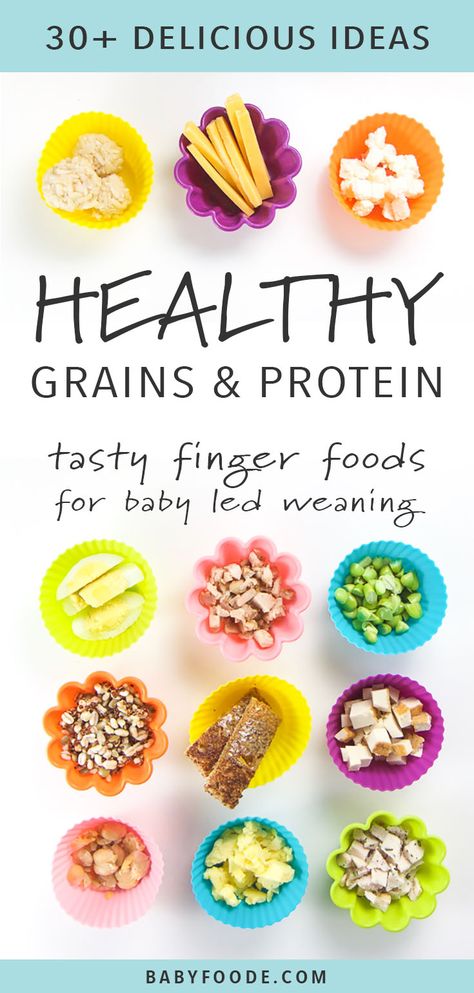 They’ll suck on the top part like a little popsicle! You can also help them hold the banana if needed.
They’ll suck on the top part like a little popsicle! You can also help them hold the banana if needed.
Foods to Avoid Serving While Doing BLW
You want any foods you offer to a baby while doing baby led weaning to be soft enough to squish between your fingers and safe for them to eat and digest. Plan to avoid:
- Anything hard, sticky, or crunchy (like raw apple or carrot, whole nuts, crackers, or a big spoonful or nut butter)
- Added salt
- Cow’s milk (which is difficult for kids under 1 to digest; plain yogurt is fine though)
- Added sugar (they simply don’t need it)
- Honey (to avoid a risk of botulism)
- Super slippery foods that would be hard for baby to hold (which can be frustrating)
TIP: Always sit with your baby and watch them try to eat. They are your best guide for making adjustments to the foods you serve.
Baby Led Weaning and Choking
There are many parents who dislike this method of feeding because it often sounds like a baby is choking. And while there are surely some incidences of choking, what’s more likely is that a baby will occasionally gag on a piece of food that gets into their mouth that they weren’t expecting.
And while there are surely some incidences of choking, what’s more likely is that a baby will occasionally gag on a piece of food that gets into their mouth that they weren’t expecting.
But remember: Gagging is a sign that baby is doing what she needs to in order to move the food around in their mouth as they learn to eat. It usually sounds more dangerous than it actually is.
TIP: If the sound of gagging really freaks you out, you’re not alone. Consider offering more preloaded spoons with purees to start your journey more slowly.
How to Cut Foods for BLW
You generally want the food to be big enough that it would be difficult for baby to put the entire thing into their mouths. Here are some specifics:
- Foods that are roughly the size of a finger, so about a 4-inch stick.
- Foods that are easy for the baby to pick up—they can’t pick up small pieces until closer to 9 months when they develop the ability to use their fingers in what’s known as a “pincer grasp”.
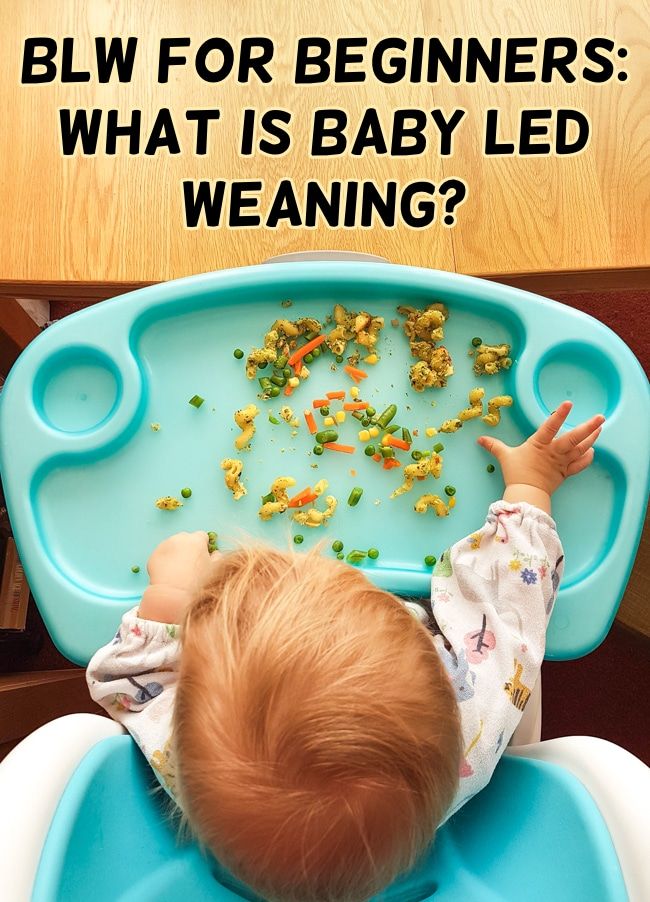
- Foods that aren’t too slippery—so you can wash and leave some of the peel on fresh foods like bananas, avocado, kiwi, and mango.
TIP: You can also go even bigger if you’re worried about size. Think half of a slice of bread or a big chunk of watermelon.
Will my baby actually eat much food with BLW?
Probably not at first. There will likely be more tasting of the food than eating of it and that is totally fine. They will still rely on breast milk or formula at this age for their main nutrition, so don’t expect them to suddenly start eating full meals. (They’ll get there in a few months, but it takes time!)
Do babies need teeth for baby led weaning?
No! Gums are super strong and front teeth aren’t used for chewing—that happens when the back molars come in. Teeth really have nothing to do with whether or not a baby can eat solids.
TIP: Learn more about what to expect from teething here.
Can you mix baby led weaning and purees?
Absolutely! I think it’s a great idea to mix the two methods simply because it gives you many more options for foods and allows the baby to experience more textures. I recommend allowing babies to feed themselves preloaded spoons—so you put the puree on a spoon, then hand it to them to actually put the spoon into their mouth—so they still have control over what goes into their mouths.
I recommend allowing babies to feed themselves preloaded spoons—so you put the puree on a spoon, then hand it to them to actually put the spoon into their mouth—so they still have control over what goes into their mouths.
TIP: Feeding some purees is also helpful if you’ll be sending food with a baby to daycare since the care provider may not have experience with blw.
Best First Foods for Baby: Purees
Here are some of our favorite purees to start offering baby when they’re ready to start solids. Remember: There’s no evidence that says that you need to start with vegetables versus fruits, so go with something that tastes good to you. Start with single foods pureed smooth and offer just a little at a time on a spoon.
- Mashed roasted sweet potato puree
- Mashed avocado puree
- Mashed banana puree
- Butternut squash puree
- Applesauce, unsweetened
- Mashed pea puree
- Oatmeal baby cereal (with added iron)
TIP: One of my favorite baby food companies is Amara Organic Baby Food, a company using a nutrient protection technology that makes organic purees just as good as homemade.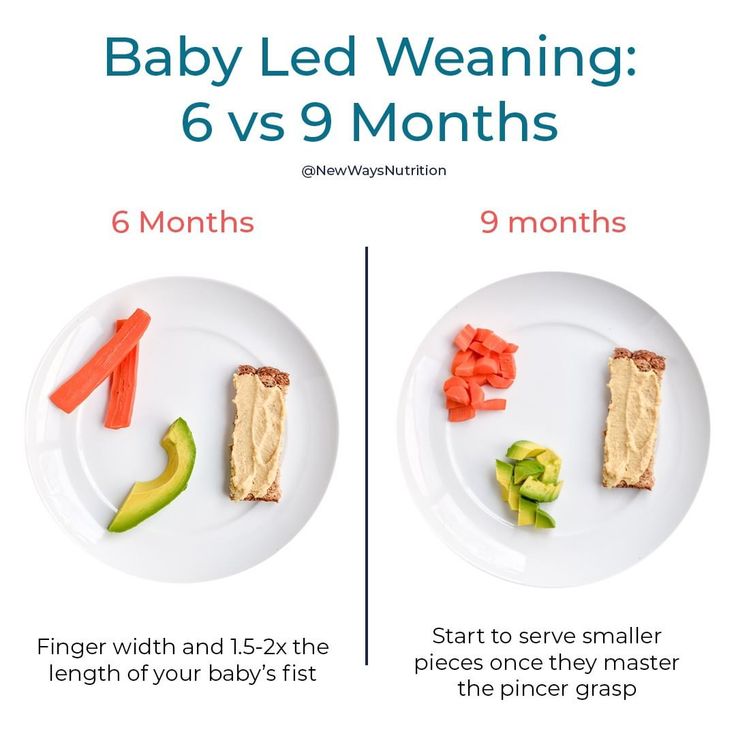 I love how easy they are to use when I need a shortcut and that they have fun baby-led weaning recipes on the side of every box! (paid affiliate link)
I love how easy they are to use when I need a shortcut and that they have fun baby-led weaning recipes on the side of every box! (paid affiliate link)
How do I know when baby has had enough?
If your baby is eating and then starts to turn her head away or just refuses to open her mouth, she’s done! Babies may also start to fuss if they’ve had enough. Learning this new skill takes time and babies can become tired fairly quickly into the process, so don’t expect them to always eat very much or to last very long at the table. This stage is about exploration!
Baby with preloaded spoon of yogurtHow to Let Baby Self Feed Purees
I love offering purees on a preloaded spoon. To do this, the parent, puts some of the food on the spoon and hands it to baby. Then baby can bring the food to their mouth all by themselves. This gives you some of the same advantages of baby led weaning, but can be more comfortable for many parents.
Remember, you can mix what you offer, going back and forth between purees and blw finger foods, so you can offer the same food two different ways to let baby explore.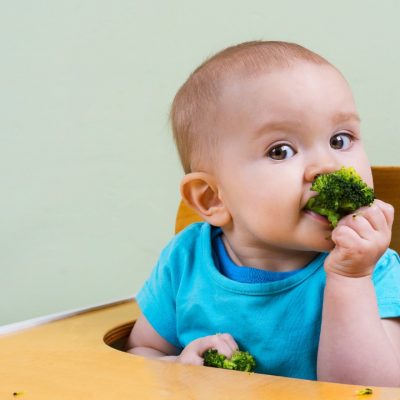 The main goal is to avoid forcing baby to take more bites than they want to, which can sometimes happen with purees.
The main goal is to avoid forcing baby to take more bites than they want to, which can sometimes happen with purees.
When to Introduce Potentially Allergenic Foods
In recent years, guidelines have been updated on when to introduce potential allergens including peanuts, eggs, and shellfish, so unless you have a family history of a food allergy, you can go ahead and introduce them soon after baby starts eating solids. In fact, research is showing that introducing these foods early can actually protect baby from developing an allergy. Talk to your pediatrician if you have concerns.
TIP: Thin unsweetened peanut butter with water to form a very thin Peanut Butter Puree until it’s about the consistency of regular yogurt and offer a very small amount on a spoon or spread on a toast stick.
What does a baby led weaning meal look like for months 7 and 8?
Until a baby is closer to 9 months and is able to pick up smaller pieces of foods, but after they have gotten the hang of one food at a time, I try to offer 1-2 foods they can feed themselves and one puree.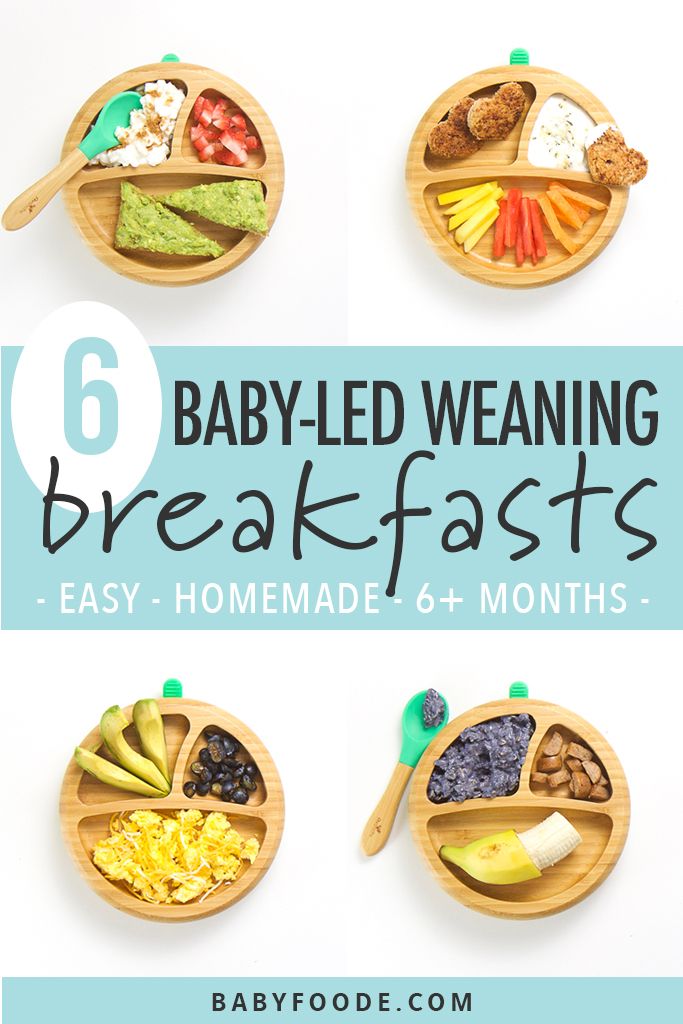 This offers them a chance to ingest more via the puree but still feed themselves a range of textures. You can do more or less food following the lead of the child.
This offers them a chance to ingest more via the puree but still feed themselves a range of textures. You can do more or less food following the lead of the child.
TIP: My Baby Food Chart has loads of with ideas for blw foods and purees by month.
Recipes for Every Stage of Starting Solids
If you’re ready to start solids with baby, or you’re just curious what it looks like to do a mix of baby led weaning and purees, check out my Yummy Baby Food cookbook. It goes stage by stage with specific foods to start in each, with simple recipes and easy feeding tips.
Listen to a recent podcast episode to hear about some of the basics of BLW with our guest Megan McNamee, MPH, RDN, CLT, and a Registered Dietitian Nutritionist specializing in pediatric nutrition who runs Feeding Littles.
I’d love to hear any questions you have with BLW or if your baby had a first food that I didn’t list here. Please comment below to share your experience!
Prep Time 5 minutes
Total Time 5 minutes
Author Amy Palanjian
Cuisine American
Course Dinner
Calories 28kcal
Servings 1
Banana
- ▢ 1 small ripe banana with peel on
Roasted Sweet Potato
- ▢ 1 small sweet potato + 1 teaspoon olive oil
Roasted Apple
- ▢ 1 small apple + 1 teaspoon butter or neutral oil
Roasted Broccoli
- ▢ 1 cup broccoli florets + 1 teaspoon olive oil
Sauteed Green Beans
- ▢ 4 green beans 1 teaspoon olive oil
Melon
- ▢ 1 small piece watermelon or cantaloupe
Avocado Toast
- ▢ 1 slice whole grain bread
- ▢ 1 tbsp ripe avocado
Avocado Spear
- ▢ ⅛ ripe avocado
Lamb or Beef
- ▢ 1 lamb chop, roast, or steak
Pan-Seared Chicken Thighs
- ▢ 1 chicken thigh
- ▢ 1 tsp olive oil
- ▢ 1 garlic clove, optional
Banana with some of the peel still on
Cut a banana in half.
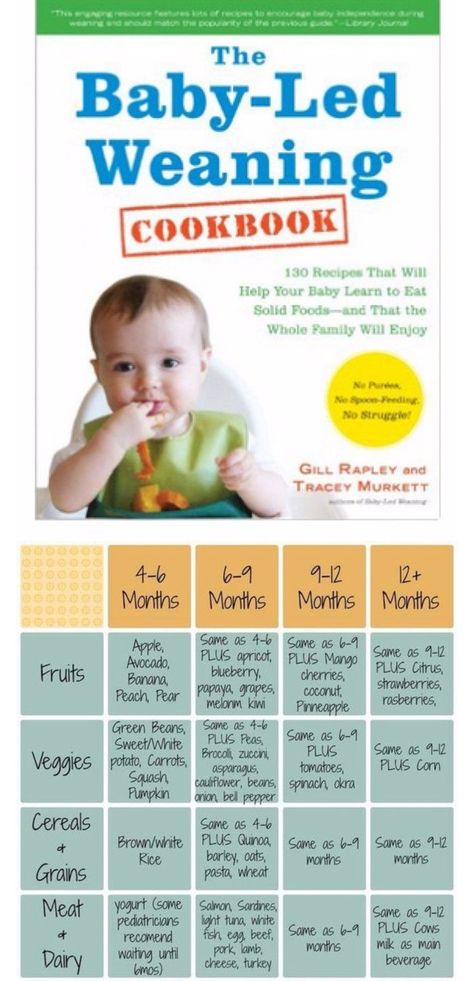 Use a knife to gently cut around the peel about 2 inches down, leaving some of the peel on so that the banana is easy for baby to hold and less slippery.
Use a knife to gently cut around the peel about 2 inches down, leaving some of the peel on so that the banana is easy for baby to hold and less slippery.
Roasted Sweet Potato Wedges
Preheat oven to 400 degrees and line a rimmed baking sheet with foil. Wash and dry the sweet potato. (You don't need to peel it.) Cut in half, then cut lengthwise into strips. Cut each strip in half again until each is about 1/2-inch thick. Slice in half horizontally if the sweet potato is very long. (Each strip should be about the size of your finger.) Place into a bowl and toss with the olive oil. Spread onto prepared baking sheet and roast for 22-25 minutes or until soft. Let cool slightly and serve.
Roasted Apple Wedges
Roasted Broccoli Florets
Preheat the oven to 400 degrees F. Place the broccoli onto a rimmed baking sheet and toss with the olive oil, coating and mixing well until all of the florets are a little shiny and coated with oil.
 Roast for 15-18 minutes or until tender. Let cool slightly and serve.
Roast for 15-18 minutes or until tender. Let cool slightly and serve.
Sauteed Green Beans
Warm the oil in a large skillet over medium heat. Add the green beans and stir. Cover and cook for about 8 minutes. Remove cover and taste one to see if it’s soft enough. Cook for an additional minute or two as needed.
Melon slices
Avocado Toast
Avocado Spears
(Make sure the avocado is ripe and soft): Cut a thick strip of avocado and offer to baby. You can leave the peel on if that makes it easier for baby to hold (just wash it first).
Lamb or Beef
Prepare a roast, steak, or chop without salt and with butter or olive oil until cooked medium well. Offer a thick slice at least the size of your finger or a drumstick.
Pan-Seared Chicken Thighs
Warm 1 tablespoon olive oil or butter in a large skillet over medium heat. Add the chicken thigh and top with a few slices of fresh garlic, if desired.
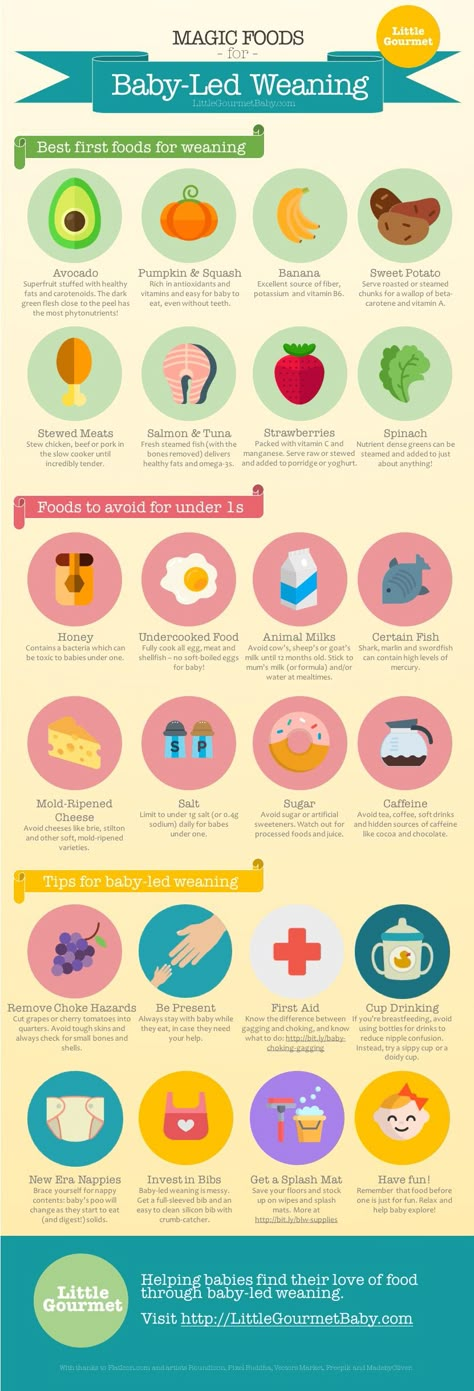 Cover and cook for 4-5 minutes. Remove cover. Flip over and cook for an additional 4-5 minutes uncovered or until a meat thermometer registers 165 degrees F.
Cover and cook for 4-5 minutes. Remove cover. Flip over and cook for an additional 4-5 minutes uncovered or until a meat thermometer registers 165 degrees F.
- Add spices like garlic powder, cinnamon, cumin, oregano, or any other non-spicy flavor you like to make these more interesting.
- Offer just one piece at a time when starting out.
- If baby gnaws a piece down into a smaller piece, replace it with a larger one to avoid her putting a chunk of food into her mouth.
- Store any leftovers in an airtight container in the fridge for 3-5 days. Reheat briefly if needed.
- Remember that it's normal for babies to take time to actually ingest the food. Part of the process is exploring all of the senses related to the experience of eating.
Calories: 28kcal, Carbohydrates: 2g, Protein: 1g, Fat: 2g, Saturated Fat: 1g, Polyunsaturated Fat: 1g, Monounsaturated Fat: 2g, Sodium: 6mg, Potassium: 75mg, Fiber: 1g, Sugar: 1g, Vitamin A: 23IU, Vitamin C: 2mg, Calcium: 2mg, Iron: 1mg
Tried this recipe?Rate in the comments and tag @yummytoddlerfood on IG!
Starting Your Baby on Food
Weaning is the process by which babies who were fully reliant on milk are introduced to solid foods.
It starts with the first mouthful of food and ends with the last feed of breastmilk or formula milk (1).
When and how solid foods are introduced is vital to establishing healthy eating habits and limiting fussy eating.
This article provides successful weaning tips, including foods to choose and avoid, proper timing and potential concerns.
Most health experts recommend that babies begin getting solid food at around 4-6 months of age (2, 3, 4, 5).
Six months is often recommended because babies, at this age, begin to need extra nutrients not found in milk, such as iron and zinc (6, 7).
Small amounts of solid food can provide these nutrients.
Experts also suggest looking for signs that a baby is developmentally ready for solids. These include (8, 9):
- Sitting up well
- Good head control
- Can hold food in their mouth and is willing to chew
- Can pick up food and put it in their mouth
- Is curious at mealtimes and keen to get involved
It is rare for babies to be ready for solids before 4-6 months.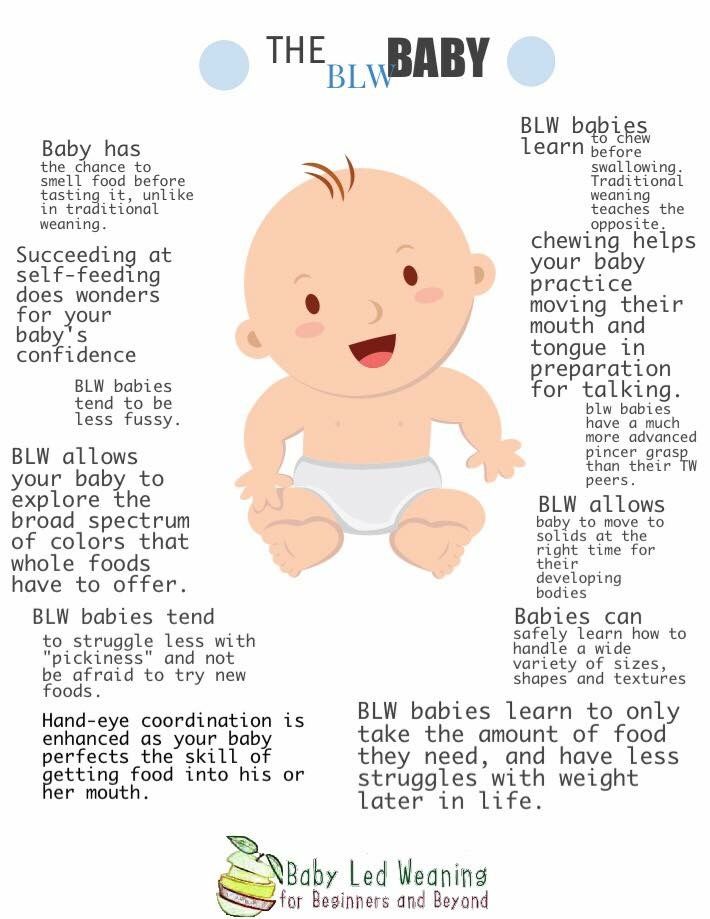
If you think your baby is showing signs that they are ready for solids but aren’t yet 6 months old, speak to your pediatrician for advice.
SummarySolids should be introduced at 4-6 months of age when babies require additional nutrients that cannot be obtained through milk alone.
Weaning is typically divided into two main approaches: traditional and baby-led.
There is no one correct way to start your baby on solids. That said, knowing the advantages and disadvantages of each approach can help you make the best decision for you and your baby.
You can also mix these methods to determine what’s most appropriate.
Baby-Led Weaning
In this method, babies are encouraged to self-feed from the start. You can introduce solid foods as finger foods and allow your child to explore solids at their own pace.
Pros
- It encourages independent eating sooner.
- Babies may be more likely to decide when they are full and less likely to be overweight in the long term (10).

- It reduces the need for separate cooking, as family meals are usually appropriate.
- Your whole family can eat together.
Cons
- It increases concerns around gagging and choking. However, if offered appropriate foods, your baby’s risk of choking should not be higher than under a traditional approach (11).
- It’s difficult to know how much food your baby has eaten.
- It can be messy.
- It may be more difficult to identify food allergies, as several foods are often introduced at once.
Traditional Weaning
In this approach, you feed your baby and gradually introduce it to more solid foods. You’ll begin with smooth purees before moving to mashed and chopped foods, then finger foods and finally small bites.
Pros
- It’s easier to see how much your baby has eaten.
- It’s less messy.
Cons
- Making separate meals and having to feed your baby can be time-consuming.
- There may be a higher risk of overfeeding, as you might struggle to read your baby’s fullness.

- If babies get too used to smooth purees, it may be difficult to move them to other textures.
SummaryBaby-led weaning encourages infants to feed themselves, whereas you feed your child a progressively more solid diet under the traditional method. Both approaches have advantages and disadvantages.
First tastes are important for developing good eating habits and exposing your infant to a wide variety of flavors.
When introducing new foods, remember that the amount eaten is less important than the number of foods tried. In the beginning stages of weaning, your baby will still get most of its nutrition from breastmilk or formula.
Try to make this a positive experience for your baby by allowing them to play with, touch and taste new foods.
Around an hour after a milk feed and when your baby isn’t too tired is often a good time to try food. Mixing foods with a little breastmilk or formula milk can improve acceptance.
Appropriate first foods include:
- Soft, cooked vegetables: Broccoli, carrot, potato, sweet potato, butternut squash, pumpkin, peas — pureed, mashed or served as finger food
- Soft fruit: Banana, mango, blueberries, raspberries, avocado, cooked pear or apple, plums, peaches — pureed, mashed or served as finger food
- Cereals: Oatmeal, rice, quinoa, millet — cooked, mashed or pureed to a suitable texture and mixed with a small amount of breastmilk or formula milk
Start with a few spoonfuls or a couple of bites once a day for about a week to gauge whether your baby wants more or less.
New foods can be introduced every day or so, and you can also combine foods. For example, try mixing infant rice cereal with pear — or banana with avocado.
You can also start offering sips of water in a cup to get your baby used to it.
SummaryFirst tastes are all about experimentation and introducing your baby to a wide variety of foods.
You can give your infant fruits, baby cereals and cooked, soft vegetables.
Once your baby is around 4-6 months old and regularly eating solid food, you can offer a wider variety in order to slowly build up to three meals daily.
Make sure to offer different textures and watch for signs that your baby is full.
You can begin including:
- Meat, poultry and fish: Ensure these are soft and easy to manage. Remove any bones.
- Eggs: Make sure they’re cooked well.
- Full-fat dairy products: Plain yogurt and cheese are good options.
- Gluten-containing grains and cereals: Choices include pasta, couscous and barley.
- Pulses: Your baby might like butter beans, lentils, peas and chickpeas.
- Finger foods: Try rice cakes, breadsticks and cooked pasta, as well as soft fruits (banana, pear, mango, avocado) and soft, cooked vegetables (carrot sticks, sweet potato wedges, broccoli).
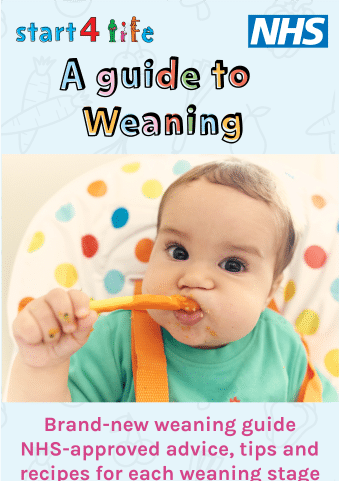
- Nuts and seeds: Ensure these are finely ground or given as a nut butter. Whole nuts should not be offered to children under 5 years old. Watch closely if there is a family history of nut allergies.
At around 7–9 months, many babies can manage three small meals each day. Try to include a source of protein, carbs and fat at each meal.
At around 9–11 months, many babies can manage family meals cut into small bites. They should also be offered harder finger foods, such as raw pepper, zucchini, apple, carrot, crackers and pita bread.
By this age, most babies can manage three meals daily and possibly a dessert, such as plain yogurt and/or fruit.
At 1 year old, most babies can eat what the rest of the family eats and join family meals. At this stage, many babies can consume three small meals plus 2–3 snacks daily.
Remember that each baby is different — your baby may eat more or less depending on its own needs.
SummaryOnce your baby is trying various types of food, you can gradually give it more solids.
At 12 months, babies should be eating three small meals and a few snacks each day.
Although it’s important that your baby eats a wide variety of foods, there are some foods that should be avoided, including (12, 13, 14):
- Honey: Never give honey to infants under the age of 12 months due to the risk of botulism, a serious form of food poisoning.
- Undercooked eggs: These may contain Salmonella bacteria, which can make your baby ill.
- Unpasteurized dairy products: Pasteurization kills bacteria in dairy products that may cause infection.
- Sugary, salty or highly processed foods or drinks: These usually supply very few nutrients. Sugar can damage teeth, and babies’ kidneys cannot cope with too much salt. Avoid adding salt to family meals.
- Whole nuts: Do not give to babies and children under 5 years due to choking risk. Consult your pediatrician before introducing nut products if there’s a family history of nut allergies or if your child has other allergies.
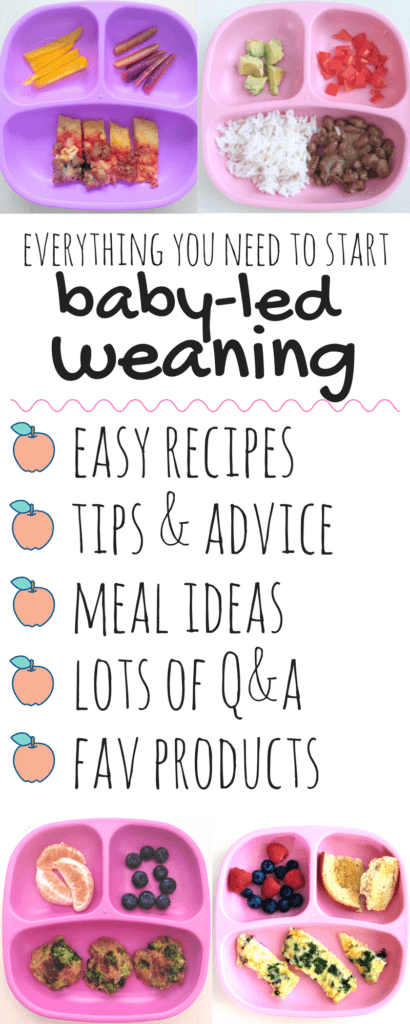
- Low-fat products: Babies need proportionately more fat in their diet than adults.
- Cows’ milk: You can add cows’ milk in small amounts to foods. However, it should never be used as a main drink or given in large amounts as it does not provide enough iron or nutrients for your baby.
SummaryAlthough it’s important to expose babies to a wide range of foods, there are certain foods you should never give your baby. These include honey, undercooked eggs and whole nuts.
Certain practices can ease the weaning process. Here are a few tips:
- Babies naturally prefer sweeter tastes. Therefore, try to offer vegetables prior to fruit to limit the chances that your baby will reject vegetables.
- Offer plenty of variety. Try to avoid giving the same foods repeatedly. If your baby doesn’t like certain foods, keep introducing it and try mixing that food with a well-liked food until your child becomes familiar.
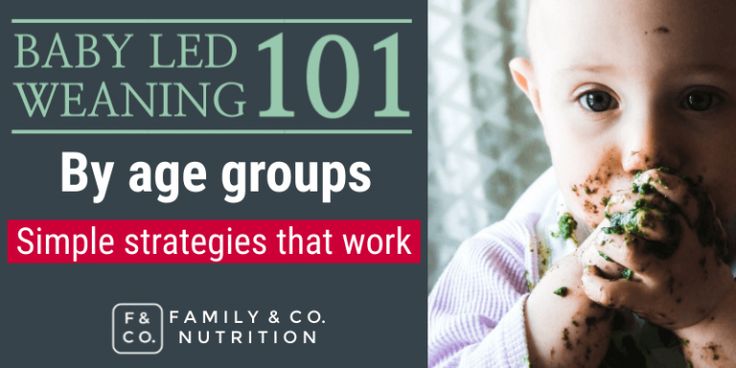
- Do not force your baby to eat more than they want to, as they usually stop when they have had enough.
- Make mealtimes relaxed and allow your baby to make a mess. This encourages babies to experiment more with food and create a positive association with eating.
- Plan ahead by freezing batches of food in ice cube trays or small containers if you don’t want to cook every day.
- Try to include your baby in family meals. Babies are more likely to eat foods that they see others around them eating (4).
SummaryCertain practices can help make weaning more successful, such as including your baby at family meals, offering savory foods before sweet ones and allowing your baby to make a mess.
Although weaning should be fun and engaging, there are a few risks to be aware of.
Food Allergies
Although a varied diet is important, there a chance that your baby may be allergic to certain foods.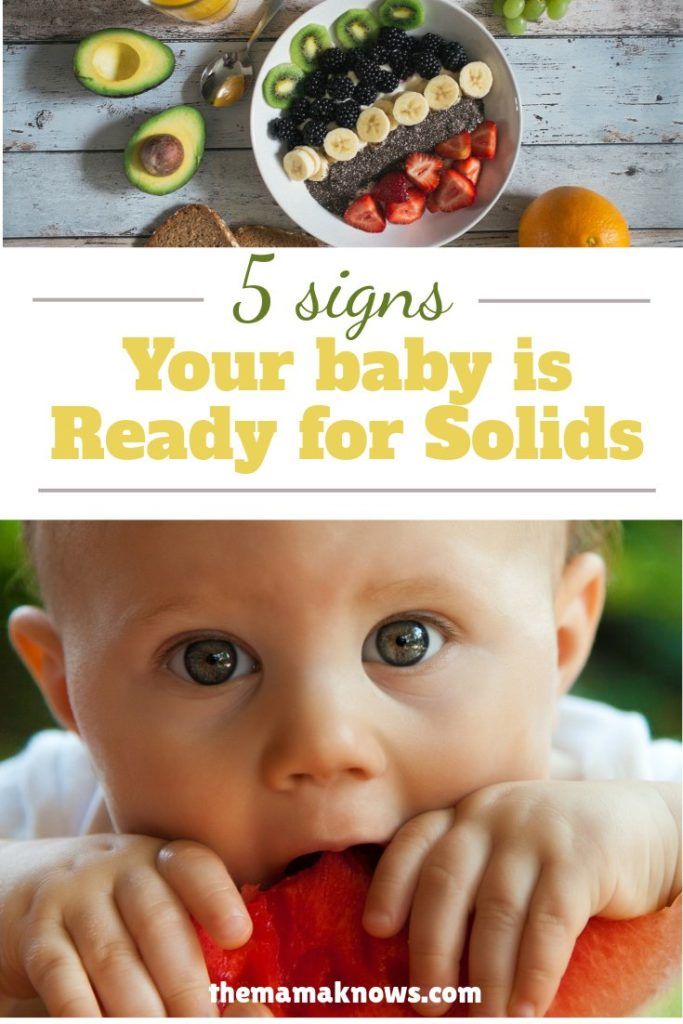
The risk is much higher if there is a family history of food allergies or if your child has eczema (15).
Despite popular belief, there is no evidence that delaying the introduction of certain foods after 6 months of age will prevent allergies (16).
Meanwhile, there is some evidence to suggest that introducing almost all foods between 4 and 6 months of age may reduce the risk of allergies and celiac disease (17, 18).
In fact, several observational studies found that introducing a variety of foods earlier than 6 months may prevent food allergies — especially in higher-risk children (18, 19).
If you have any concerns about food allergies, be sure to talk to your pediatrician.
Choking
Choking can be a significant concern when starting a baby on solid food.
However, it’s important to know that gagging is a completely normal part of learning to eat. It acts as a safety reflex to prevent babies from choking (20).
Signs of gagging include opening the mouth and thrusting the tongue forward, spluttering and/or coughing. Your baby may appear red in the face.
Your baby may appear red in the face.
It is important not to panic or get very anxious when a baby gags.
However, choking is much more serious. It occurs when food blocks the airways, meaning that your baby cannot breathe properly.
Signs include turning blue, silence and inability to make noise. Your baby may also start coughing or — in severe cases — lose consciousness.
Here are some helpful tips to reduce the risk of choking:
- Sit your baby upright while eating.
- Never leave your baby unattended while eating.
- Avoid high-risk foods, such as whole nuts, grapes, popcorn, blueberries and meat and fish that could contain bones.
- Don’t give too much food at once or force-feed your baby.
If your child does choke, you should be aware of appropriate next steps. Taking a first aid course can be helpful.
If you feel that your child is choking and isn’t able to cough up the food, call emergency services immediately.
SummaryFood allergies and choking are common concerns during weaning.
That said, certain practices — such as introducing foods individually and avoiding certain high-risk foods — can substantially reduce the risk.
Weaning is a vital process in which your baby transitions from breastmilk or formula to food.
Whether you choose baby-led or traditional weaning, or a mix of both, you should begin giving your baby soft fruits, veggies and cereals at around 4-6 months.
You can then progress to other foods.
Keep in mind that you’ll want to avoid certain foods and keep an eye out for allergies and choking.
To improve the chances of successful weaning, make mealtimes relaxed and enjoyable, allow your baby to make messes and include them in family mealtimes as much as possible.
what products are possible, features of complementary foods
It is no secret that young and not very experienced mothers receive information on the nutrition of an infant, including recommendations on how to introduce the first complementary foods, mainly from two sources: grandmother's stories and from the Internet. Unfortunately, both of these respected sources of information may voluntarily or not voluntarily, but be very mistaken, since grandmothers grew up in a more prosperous time in terms of environmental conditions, and the Internet is littered with various articles that are rarely written by professionals, moreover, they rely either on explicit outdated guides on baby food, or frankly on unverified information. nine0003
Unfortunately, both of these respected sources of information may voluntarily or not voluntarily, but be very mistaken, since grandmothers grew up in a more prosperous time in terms of environmental conditions, and the Internet is littered with various articles that are rarely written by professionals, moreover, they rely either on explicit outdated guides on baby food, or frankly on unverified information. nine0003
In this article, I will try to combine the latest scientific data and recommendations on how to introduce the first complementary foods with many years of observations from the experience of a practical pediatrician and an allergist-immunologist.
At what age is it time to introduce the first complementary foods
According to the recommendations of the Research Institute of Nutrition of the Russian Academy of Medical Sciences, the first complementary foods can be introduced from 4.5 - 5 months, regardless of the type of feeding. This is "average".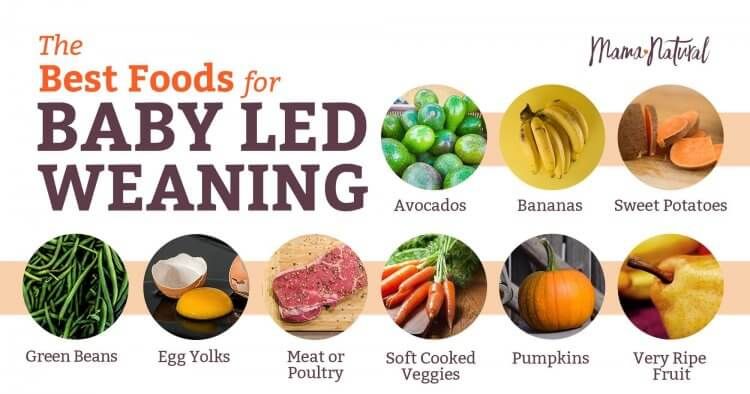 In practice, the choice of when to start introducing complementary foods still depends on the individual characteristics of the child. For example, for a child with widespread atopic dermatitis (diathesis), we will not introduce complementary foods until at least acute skin symptoms, such as cracks, weeping or secondary eczema, have steadily disappeared. Increased dryness and flaking of the skin, of course, require constant application of moisturizers to the skin, but in no case are they a contraindication to the start of the introduction of the first complementary foods. nine0003
In practice, the choice of when to start introducing complementary foods still depends on the individual characteristics of the child. For example, for a child with widespread atopic dermatitis (diathesis), we will not introduce complementary foods until at least acute skin symptoms, such as cracks, weeping or secondary eczema, have steadily disappeared. Increased dryness and flaking of the skin, of course, require constant application of moisturizers to the skin, but in no case are they a contraindication to the start of the introduction of the first complementary foods. nine0003
Another important point when choosing the time to start introducing complementary foods is the dynamics of the child's weight gain. The more intensively the child gains in height and weight, the sooner he may need additional calories, since the energy value of breast milk or artificial formula alone will most likely not be enough for a child who grows faster than his peers by 4 - 5 months. We must not forget that natural products contain a fairly large range of minerals and vitamins, and a mother’s body, alas, cannot be an eternal and bottomless source of useful nutrients, somewhere something will gradually begin to be missed. nine0003
nine0003
In addition, the nature of lactation in the mother has a great influence on the timing of the introduction of complementary foods. If a nursing mother begins to feel a lack of milk, I would prefer to first give her advice on stimulating lactation, and at the same time begin to introduce complementary foods. It will be better than introducing an artificial mixture. But I repeat that the earliest start date for the introduction of the first complementary foods is the age of 4 months, before the child's body is not yet ready, the risk of developing allergies is also high.
So, we agree with you that the first complementary foods can be introduced no earlier than 4 months of a child's life.
First complementary foods: Which foods to choose?
The first complementary foods, as a rule, should consist of vegetable or fruit purees, but in no case juices. Still, juices, even for children, are highly filtered, mainly contain a large amount of organic acids and “light” carbohydrates (that is, sugar, to make it clear to everyone).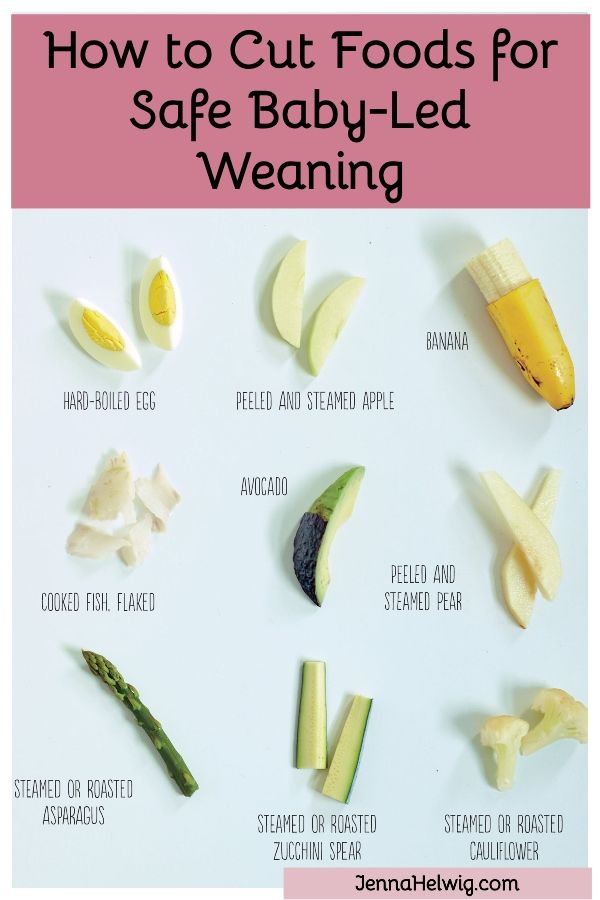 I will not waste time explaining why juices are harmful to an infant, but I will describe a clinical case from practice. nine0003
I will not waste time explaining why juices are harmful to an infant, but I will describe a clinical case from practice. nine0003
Parents with an 8-month-old girl came to the reception. Somewhere from 5 months she practically did not gain weight, although before that all indicators were normal. In the analyzes, apart from visible signs of iron deficiency, slightly reduced hemoglobin, no pathology was also detected. The main complaint: "does not eat anything." And when I began to find out what she still eats, it turned out that the child drinks half a liter of juice every day. But porridge or cottage cheese, or mashed potatoes cannot be forced together, they spit everything out. I don't like the taste. And so - for three months. The child, of course, became very nervous, yelling at night, demanding juice. nine0003
So draw your own conclusions and be careful.
For the first feeding, this is now recognized by everyone, the best dishes are vegetable purees from green varieties of vegetables: zucchini, cauliflower, broccoli. The first complementary foods are introduced, starting with half a teaspoon, in the morning for three days, then gradually increase the amount of the product to 40-50 grams per week. Supplemented with breast milk or formula.
The first complementary foods are introduced, starting with half a teaspoon, in the morning for three days, then gradually increase the amount of the product to 40-50 grams per week. Supplemented with breast milk or formula.
For problems with stools, constipation, it’s good to start introducing prune puree, green apple, you can try pumpkin, even apricot puree, but in no case start with carrots. Beta-carotenoids, which are abundant in carrots, are generally poorly absorbed and can cause allergies in a child. nine0003
Second food. Porridge or meat?
Even 5 - 6 years ago, we taught students at the medical institute that from 5 - 5.5 months old, an infant should begin to give cereal porridge for complementary foods. This is rice, buckwheat, corn. The first week you can cook 5% porridge: 5 grams of ground cereal per 100 ml of water. Then the porridges are cooked already denser: 10 grams of cereal per 100 ml of water. But now, basically everyone uses instant (soluble) cereals, which are diluted with water according to the instructions on the package.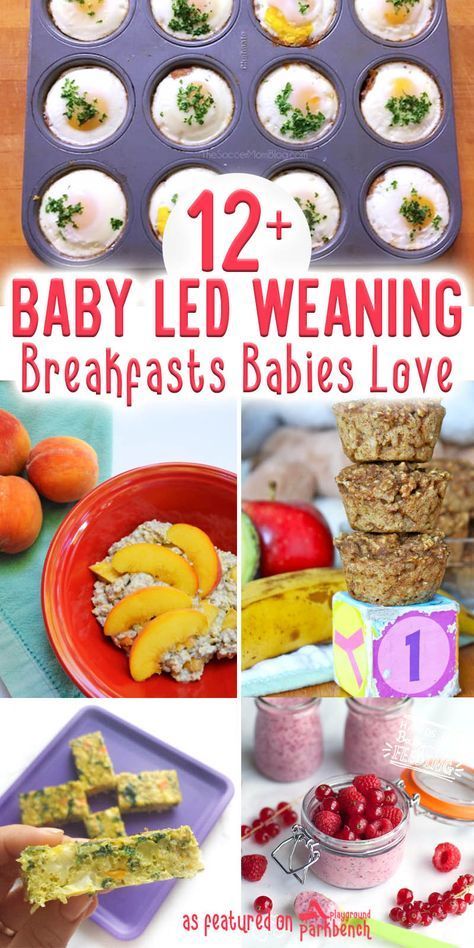 In addition, ready-to-eat liquid cereals are on sale: for example, Bellakt, Frutonyanya, etc. nine0003
In addition, ready-to-eat liquid cereals are on sale: for example, Bellakt, Frutonyanya, etc. nine0003
Why meat? You ask. According to modern recommendations (they really began to change quite often), but in this case I support: if a child has a pronounced decrease in hemoglobin in the blood below 100 g / l by the age of 5 months, it makes sense to start introducing fruit or vegetable purees as a second types of complementary foods - meat purees as a source of the most well-absorbed heme iron. You need to choose from varieties such as turkey, rabbit, lamb. Beef and veal can only be offered to children who did not have red cheeks and diathesis. nine0003
In the absence of problems with low hemoglobin, feel free to introduce porridge as the second meal of complementary foods, especially if the child is small and does not gain weight very well. In this case, we can recommend breeding cereals with the addition of breast milk or a mixture (Nan, Nutrilon, Celia, Nanny). With mixtures based on goat's milk, parents of children with a predisposition to allergies should be very careful.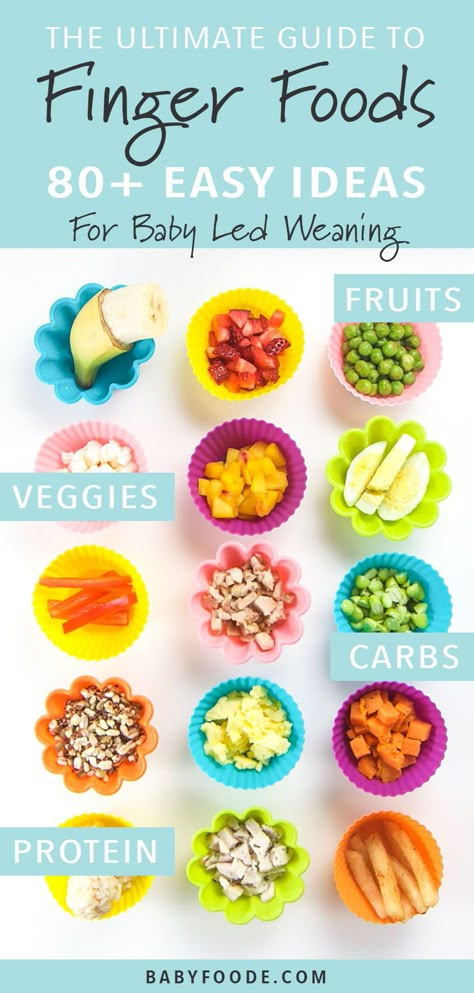 Goat milk formulas are not the best choice for babies who are allergic or intolerant to cow's milk protein, whatever the internet says. Believe me, there are serious scientific articles by foreign authors, which provided data on a very high frequency of cross-allergy between cow and goat milk proteins in children who were transferred to goat milk mixtures. And I saw it myself in my practice, when a child with dermatitis was transferred to a mixture of goat's milk, there was a clear improvement for a month or two, and then all over again and with a doubled degree of allergic skin damage. nine0003
Goat milk formulas are not the best choice for babies who are allergic or intolerant to cow's milk protein, whatever the internet says. Believe me, there are serious scientific articles by foreign authors, which provided data on a very high frequency of cross-allergy between cow and goat milk proteins in children who were transferred to goat milk mixtures. And I saw it myself in my practice, when a child with dermatitis was transferred to a mixture of goat's milk, there was a clear improvement for a month or two, and then all over again and with a doubled degree of allergic skin damage. nine0003
Introduction to fermented milk products
This is the most difficult question. I am sure that most of our grandparents demand that their stupid parents start drinking milk and kefir as soon as possible. In a number of cases, children really start to absorb sour-milk products quite well after 6 months, but before this age I am very careful even with sour-milk Agusha, and even introducing milk or kefir before 6 months is a bad form, believe me, and can lead to very bad consequences for the child.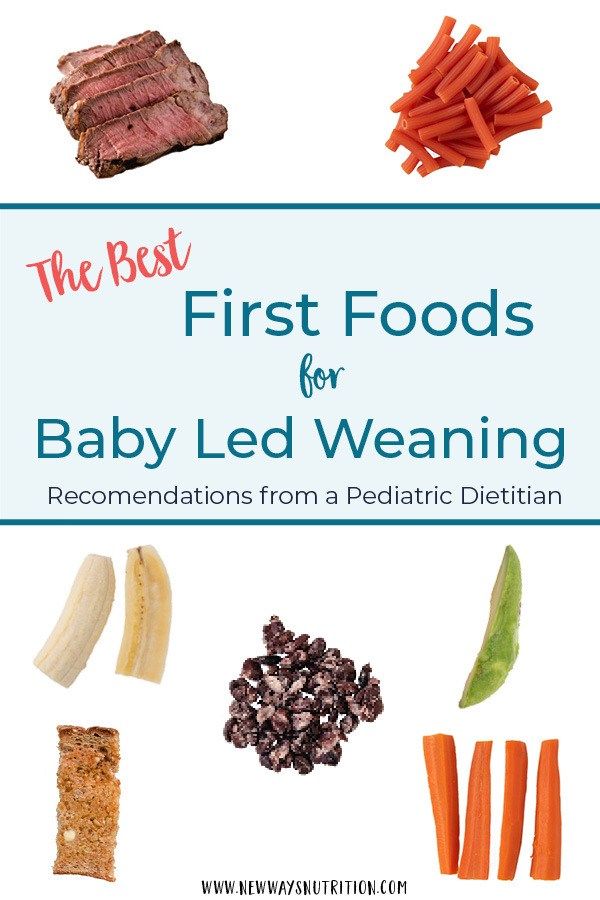 I understand the Western European medical community, which has recently banned its pediatricians from recommending fermented milk products for complementary foods for children under 3 years of age, just imagine! nine0003
I understand the Western European medical community, which has recently banned its pediatricians from recommending fermented milk products for complementary foods for children under 3 years of age, just imagine! nine0003
They (the Europeans) need to do something with their artificial milk mixtures. Even 20 years ago, we did not know other mixtures after the "two", that is, the second formula for children from 6 to 12 months. Then there were formulas for children from 1 to 2 years old, then from 2 to 3 years old, and now there are already mixtures for children up to 4 years old, and I think if this goes on, then until the age of sixteen there will be their own milk substitutes. Dismiss me, I don't think this approach is correct. But the fact is that our grandparents had much better genetics than the generation of our children, alas. In the context of the growth of medical capabilities, genetically determined diseases are also growing, and in this case, intolerance to cow's milk protein, and with every 10 years there are more and more such people among us. But if a child really suffers from an allergy to cow's milk protein or is severely deficient in enzymes, then he will carry this peculiarity through his whole life, and most likely he will not drink milk or kefir himself, and there is no need to force him if he himself won't want to! nine0003
But if a child really suffers from an allergy to cow's milk protein or is severely deficient in enzymes, then he will carry this peculiarity through his whole life, and most likely he will not drink milk or kefir himself, and there is no need to force him if he himself won't want to! nine0003
But you are lucky with genetics, and no one in the family has ever had an allergy (which is hard to imagine nowadays), and most importantly, if your child has always had perfectly clean skin, then the first of the dairy products - cottage cheese, you will begin to offer your child with 7 months, kefir - from 10 months. Milk - after a year. It will be better this way.
But if your family does not have a very close and joyful relationship with milk, then it is better to postpone even the introduction of kefir and yogurt into complementary foods for a child until the age of 18 months. nine0003
Fish day and first meal
Fish is a very healthy product, rich in vitamins and antioxidants, but it must also be introduced carefully. I advise you to start introducing the first fish food at about 7-8 months. It is better to start with species such as cod, hake, haddock. The rules are the same: the first three days on the "gram," then slowly add. If there are no problems in a week or two, you can try such delicacies as tuna or salmon, of course, canned children, if you can find it. It is better not to mess with trout and salmon in the first year of life, this fish is all stuffed with dyes and antibiotics. nine0003
I advise you to start introducing the first fish food at about 7-8 months. It is better to start with species such as cod, hake, haddock. The rules are the same: the first three days on the "gram," then slowly add. If there are no problems in a week or two, you can try such delicacies as tuna or salmon, of course, canned children, if you can find it. It is better not to mess with trout and salmon in the first year of life, this fish is all stuffed with dyes and antibiotics. nine0003
No matter how hard I tried, the article about the first complementary foods turned out to be long. Thank you for reading to the end, I hope it will be useful. If you have questions about the introduction of complementary foods, you can write your appeals on our website in the question to a specialist section. A short answer can be obtained on the Internet, but in order to make a diagnosis and give a detailed consultation, of course, you need to come to a face-to-face appointment with a pediatrician and a pediatric allergist.
Infant feeding
Breast milk contains enzymes, essential amino acids, antibodies, vitamins and other substances necessary for the growth and development of the baby. However, with age (between 6-24 months, according to WHO), the needs of the child change, and then it is necessary to introduce complementary foods. At the same time, it is not necessary to immediately turn off breastfeeding (WHO recommends breastfeeding until 2 years of age). Anna Aleksandrovna Tsaregorodtseva, a CTA pediatrician, spoke about how to competently introduce new foods into a child's diet.
You can start feeding your baby if:
- He is 6 months old or older.
- He holds his head well.
- Can touch his mouth with his hand and actively "chews" various objects.
- If you put him in a highchair or on an adult's lap, the child can sit.
- He has a food interest: when adults eat, the baby watches, pulls his hands and wants to try.
Getting Started
The first foods should be puréed to make it easier for the baby to digest them!
As a rule, the child is first introduced to vegetables. If you want to introduce vegetables from jars, then it is better to buy mono-products - so that the puree contains only zucchini or only broccoli, etc. It is best to start with zucchini. After that, you can enter cauliflower, then broccoli, then potatoes, pumpkin and carrots.
If you want to introduce vegetables from jars, then it is better to buy mono-products - so that the puree contains only zucchini or only broccoli, etc. It is best to start with zucchini. After that, you can enter cauliflower, then broccoli, then potatoes, pumpkin and carrots.
Enter at lunchtime (12-15 hours) and no more than one product at a time. Vegetable puree (like any other complementary foods) is given before breastfeeding or formula, 1 teaspoon. The next day, you need to observe the skin and stool of the child and do not give him complementary foods, but only breastfeed! If the body perceives the new product normally, in a day you can give 2 tsp already. zucchini. According to the same scheme - if everything is in order, you can increase the amount to 3 tsp. Gradually give more complementary foods (up to 5 spoons) and less and less often supplement the child with milk. When the volume of vegetables in the diet is approximately 150-200 g per day, you can stop breastfeeding your baby at this meal. nine0003
nine0003
How to enter a new dish
The 2nd dish (cauliflower) must be added to the one already entered. That is, 5 tsp. zucchini and 1 tsp. cauliflower. On the "fasting day" you can give 5 tsp. zucchini, but discard the cabbage and watch. As a result, you will give the baby 5 tsp. zucchini and 5 tsp. cauliflower.
Then you can enter the 3rd dish - broccoli - and then other vegetables. When the child is familiar with different vegetables, vegetable mixtures can be introduced.
If you want to feed your child with home-cooked vegetables, then note that it is best to boil vegetables in a double boiler. So it will be possible to save vitamins and minerals. nine0003
Fruits and berries
When the child digests vegetables well, fruits can be added to the diet. It is better to give them from jars. The time for the introduction of fruit is an afternoon snack (16-18 hours).
As the first fruit, it is better to take an apple, then a pear, then a prunes.

